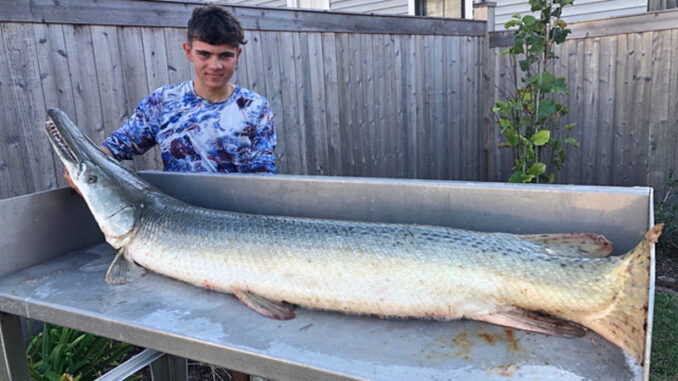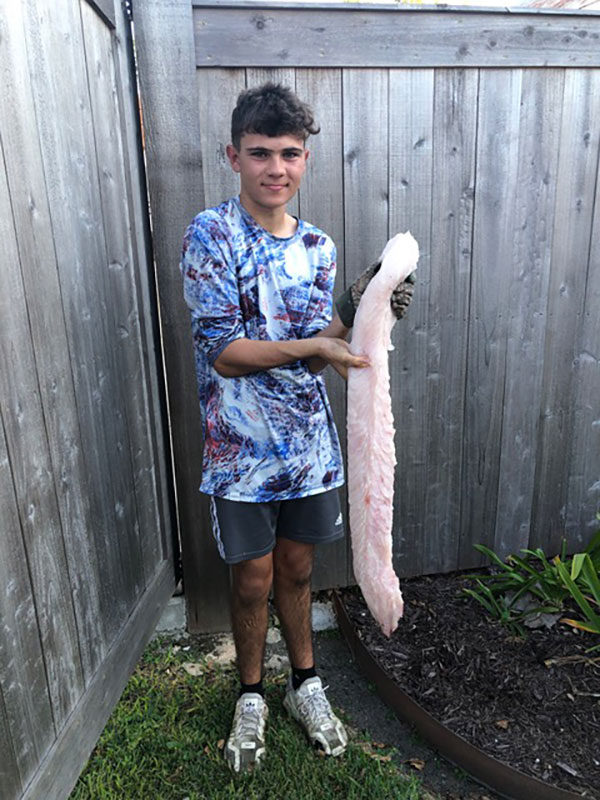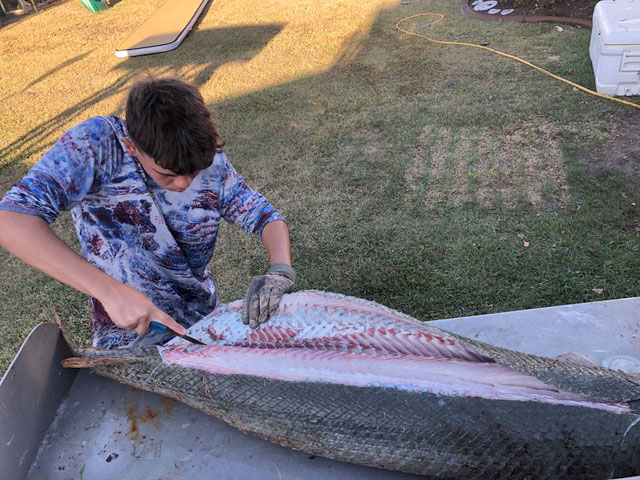
Alligator garfish.
Anyone who fishes in southern Louisiana knows that they are our version of “River Monsters.” Plentiful, they are in every body of water in the state. Impenetrable scales, long sharp teeth and a fierce fight is guaranteed.
But then what? Most would simply cut the line. Too scary and difficult to boat. Not good to eat. I hear you. Recently I have been re-educated concerning what I thought I knew about this fish. My good buddy, Baylor Allen, has devoted a lot of time to studying and researching techniques on how to most efficiently deal with these behemoths. He has put that knowledge to work and caught many gars that are longer and heavier than he is.
Baylor and I recently went down to the Atchafalaya Delta WMA, in search of Alligator Gar.
He has experienced a lot of success when targeting gar at that location. When we arrived, Baylor threw his 6 foot cast net a few times to catch some mullet for bait. Other cut bait works too, but his favorite is mullet. Using 80-pound test braided line, a 2-ounce sinker and a No. 13 circle hook, along with a heavy duty rod and reel, we set up in one of the passes that connect to the Atchafalaya Bay.
The right bite

We quickly caught a couple of 20-pound bull reds, but that was not our objective on that day. A few minutes later, Baylor recognized the bite of a gar on his line. The short pulls were abrupt as though the fish was chewing the mullet.
As the line tightened up and started to move away, Baylor opened the bail for a few seconds to help ensure the hook was set in a soft area of the fish’s bony mouth. After a few seconds, he clicked the bail and set the hook as hard as possible and the battle began. Line was stripping off at a rapid rate and Baylor said this was 100 percent a monster gar.
The first jump removed any doubt. As the battle raged, eventually he brought the fish near the boat. It was massive. A few more violent head shakes ensued. As the gar paused for a few seconds, Baylor handed off the rod to me and he carefully slipped a rope noose over the rod and onto the fish. As the noose passed the gill area, Baylor pulled tight and all heck broke loose!
With Baylor holding the rope, I reached for a 4-foot-long gaff. I was able to get the gaff in. Together we rolled the gar into the boat. The noose was the key component. We carefully secured the fish on the side of the boat using an anchor and a five gallon gas tank.
The cleaning process

But there was more. We immediately headed home to Morgan City to process our prize. A quick measurement showed the fish to be 5 foot, 10 inches long. Later the scale showed the fish weighed 66 pounds.
As the cleaning process began, Baylor advised me to be sure the fish had expired due to personal safety concerns. Running his knife under the tough scales, he made an incision near the head and another close to the tail. Using a pair of angled tin snips he began at the tail and snipped his way along the backbone. Next, he began to cut the skin away from the meat. I watched as the huge fillet came off in his hand like the back strap off a deer. He repeated this on the other side of the fish. Amazingly, in seven minutes, he had completely finished skinning and filleting the fish.
Next came the real payoff.
There are a variety of ways to cook the meat. One of the most popular is to smoke it. We put the fillets that were well seasoned with Tony Chachere’s into our smoker. Using hickory chips, it was set at 165 degrees. Five hours later, it was time for the taste test. Guys, this was some of the best tasting fish I have ever eaten.
Baylor definitely changed my attitude about Alligator Garfish. I now look forward to catching and cooking many more. How about you?